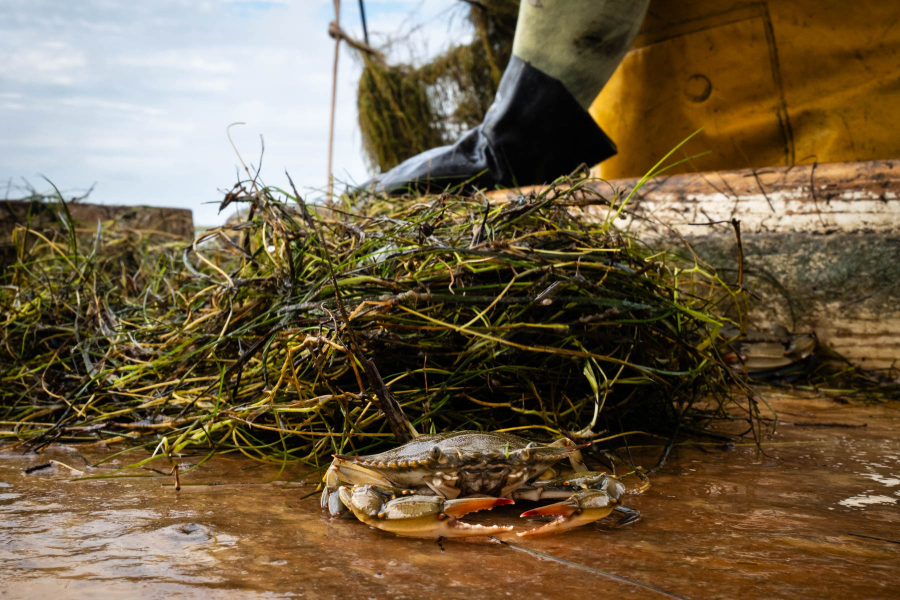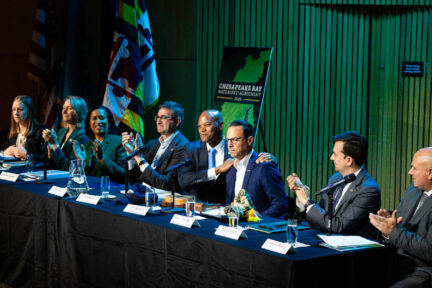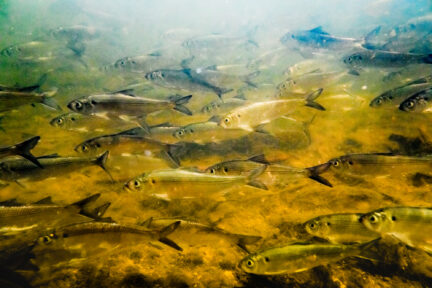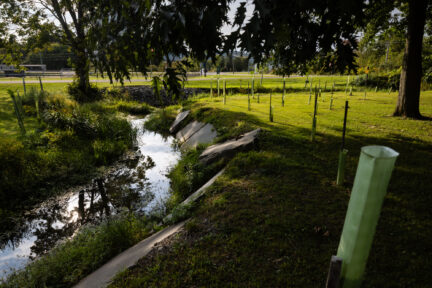Chesapeake Bay Program notes 12% increase in underwater grass abundance, continues work toward its ambitious restoration goals
Increases attributed to below-average rainfall and cooler summer weather

In 2022, an estimated 76,462 acres of underwater grasses were mapped in the Chesapeake Bay and its tidal tributaries, which is 12% higher than in 2021 and 9% higher than the long-term average taken between 1984 and 2022.
Though encouraging, this total acreage is below the targets set in the 2014 Chesapeake Bay Watershed Agreement, which includes a goal of 130,000 acres of underwater grass in the Bay by 2025, and a long-term goal of 185,000 acres that’s needed for a fully restored estuary. The 2022 numbers show 59% and 41% achievement of those targets, respectively.
Progress toward attaining these targets was significantly impeded by a severe loss in underwater grasses that occurred in 2019. Between 2012 and 2018, the abundance of underwater grass was steadily increasing, reaching roughly 108,000 acres at its peak. But from 2018 to 2019, record-high rainfall resulted in excess sediment and nutrient pollution running off into the Bay, as well as changes to the salinity of the water. This resulted in a roughly 38% drop in underwater grass, particularly the species widgeon grass (Ruppia maritima), which is sensitive to changes in water quality and weather conditions.
In 2022, the weather was more suitable for species of underwater grass, particularly widgeon grass and eelgrass (Zostera marina). The largest increases occurred in areas of the Bay with moderate to high salinity, which is where these two species are most abundant. Scientists attribute this to below-average rainfall and cooler summer weather associated with the La Nina cycle.
While eelgrass bounced back in 2021, the species has been declining over the long-term as the Bay’s mean summer temperature rises. This has allowed widgeon grass, which is more tolerant to heat, to become the most abundant species in the estuary, according to research from the Virginia Institute of Marine Science (VIMS).
Decreases in the Bay’s underwater grass in 2022 were mostly seen in areas with slightly salty water, while the freshwater tidal areas saw little change.
Beyond rainfall and temperature, efforts to limit sediment and nutrient runoff in the watershed have also helped underwater grasses rebound. Maryland, Virginia, Pennsylvania, New York, Delaware, West Virginia and Washington, D.C., all implement best management practices to reduce sediment and nutrients from entering waterways. Dry seasons make managing sediment and nutrient pollution less of a challenge.
Underwater grass abundance can vary from species to species and river to river. In 2022, other local highlights included:
- Gunpowder and Middle Rivers: Roughly 1,500 acres of underwater grass were lost in Gunpowder and Middle Rivers (over 40%), which accounted for 15% of the loss seen in the Bay’s Oligohaline Zone (slightly salty area). The reasons for the significant losses seen in this small area are unknown, and require further investigation by Bay scientists.
- Susquehanna Flats: The resurgence of underwater grass in the Susquehanna Flats has been occurring over the past several years, and in 2022, the segment gained another couple hundred acres.
- Tangier Sound: Both Maryland and Virginia’s portion of the Tangier Sound gained thousands of acres of underwater grass, increasing by 54%. These healthy grass beds will serve as high quality habitat for blue crabs, which is good news for crabbers working around Smith and Tangier Islands.
- Mobjack Bay to Poquoson Flats: The Mobjack Bay to Poquoson Flats, which is an area of the Bay dominated by eelgrass and widgeon grass, increased by 27%. Underwater grass abundance came close to reaching the record high from 1997.
- Pocomoke River: The lower Pocomoke River in Virginia increased by 32%, while the middle and upper parts of the river remained steady.
To learn more about our progress toward achieving and sustaining 185,000-acres of underwater grasses Bay-wide, visit ChesapeakeProgress.
Facts
Underwater grasses in the Chesapeake Bay are measured and calculated each year by an aerial survey conducted by the Virginia Institute of Marine Science. In some instances, satellite imagery may be used to complement the results from the aerial survey.
The Chesapeake is grouped into four different salinity zones to better reflect the various communities of underwater grasses that are found in the Bay. From 2021 to 2022, the largest increases occurred in areas of the Bay with moderate to high salinity. Experts reported the following changes in the Bay’s four salinity zones between 2021 and 2022:
- Tidal Fresh Zone: Underwater grass beds decreased 0.3% from 19,244 acres to 19,185 acres. This still represents a 93% achievement of the zone’s 20,602-acre goal.
- Oligohaline Zone (slightly salty): Underwater grass beds dropped 15% from 8,384 acres to 7,145 acres, a 69% achievement of the zone’s 10,334-acre goal.
- Mesohaline Zone (moderately salty): Underwater grass beds increased 28% from 24,091 acres to 30,932 acres, a 26% achievement of the zone’s 120,306-acre goal.
- Polyhaline Zone (very salty): Underwater grass beds increased 17% from 16,371 acres to 19,200, a 57% achievement of the zone’s 33,647-acre goal.
Issues
Like grasses on land, underwater grasses need sunlight to survive. When the waters of the Chesapeake Bay become clouded with algae blooms or suspended sediment, sunlight cannot reach the bottom habitat where these grasses grow. While healthy grass beds can trap and absorb some nutrient and sediment pollution— thus improving water clarity where they grow—too much pollution can cause grass beds to die off. High water temperatures, turbulence from strong storms and drought can also affect the growth and survival of underwater grass beds. Chesapeake Bay Program partners are working to improve water clarity, protect and restore grass beds, enhance bay grass monitoring and research and expand education and outreach to restore underwater grasses and boost their habitat benefits in the watershed.
Importance
Underwater grasses—also known as submerged aquatic vegetation or SAV—are critical to the Chesapeake Bay ecosystem. They help keep our waters clean by absorbing excess nutrients, trapping suspended sediment and slowing wave action that helps to stabilize shorelines, protect wetlands and reduce erosion. Bay grasses also provide food for small invertebrates and migratory waterfowl and habitat for fish and blue crabs. In fact, Bay grass abundance is one of several factors that can impact the health and stability of the blue crab population: the loss of these grasses is a loss of nursery habitat which can increase their vulnerability by pushing young crabs to gather in the limited nurseries that remain. In the 2023 Bay-wide Blue Crab Winter Dredge Survey, the population of juvenile blue crabs increased slightly, from 101 million in 2022 to 116 million in 2023. Researchers that study underwater grasses believe that the increase or decline of the juvenile blue crab population is in direct correlation to the increase and decrease of grass beds.
Because Bay grasses are sensitive to climate conditions and pollution but quick to respond to water quality improvements, their abundance is a good indicator of Bay health. To support the resurgence of underwater grass beds in the Bay, cities and towns can reduce polluted runoff and upgrade wastewater treatment plants with pollution-reducing technologies, farmers can use conservation practices to keep fertilizers in their fields, boaters can steer clear of bay grass beds that are growing in shallow waters, waterfront landowners can limit hardened shorelines where possible and homeowners can use rain barrels or rain gardens to slow the delivery of nutrient- and sediment-laden stormwater runoff into the Bay.
Quotes
“The increase in Bay-wide SAV acreage in 2022 is welcome news. The additional growth is encouraging because underwater grasses provide numerous benefits for the ecosystem, including crucial habitat for juvenile blue crabs. While Bay-wide nutrient reductions continue to improve water clarity, climate change is bringing more frequent and intense precipitation events, which could challenge SAV growth in the future.”
- Brooke Landry, Chair, Chesapeake Bay Program SAV Workgroup and Natural Resource Biologist, Department of Natural Resources, State of Maryland
“For the most part, we had a really encouraging year for underwater grasses throughout the Bay. The saltier areas are continuing to regain the ground lost in the 2019 crash with expansion of both eelgrass and widgeon grass, something I attribute to a combination of continued nutrient management and some cool summers associated with the La Nina cycle we are in that continues through this summer (2023).”
- Chris Patrick, Head of the Chesapeake Bay SAV Monitoring and Restoration Program and Assistant Professor of Biology, Virginia Institute of Marine Science, College of William and Mary



